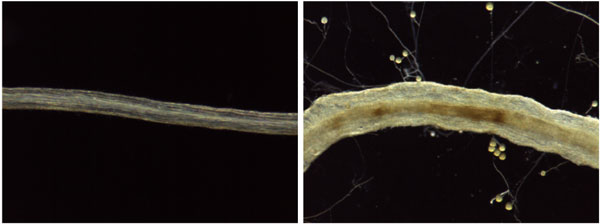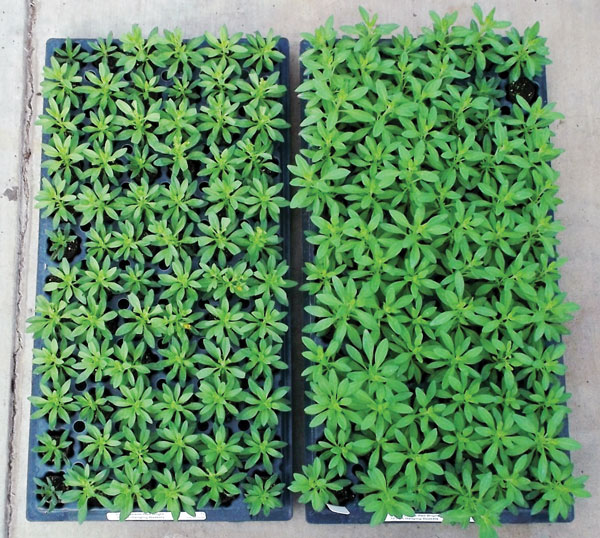5/1/2019
Mycorrhizae 101
Ed Bloodnick & Troy Buechel

There’s more awareness about the use of beneficial organisms and active ingredients for the production of ornamental crops. Active ingredients enable growers and homeowners to enhance and protect plants without the concern of chemicals. One beneficial active ingredient is mycorrhizae, which is a naturally occurring, beneficial fungus that’s safe to use. Mycorrhizae improves overall plant growth and performance, so it’s not surprising why there’s interest.
What are mycorrhizal fungi?
Mycorrhizae is a term that describes the mutualistic, symbiotic relationship between fungi and plant roots. Although there are more, the two largest classifications of mycorrhizal fungi are endomycorrhizae and ectomycorrhizae, which are characterized by their structures.
 Comparison of standard plant root on the left and root colonized by
Comparison of standard plant root on the left and root colonized by
endomycorrhizal fungi on the right.
Endomycorrhizal fungi produce thin filaments called hyphae that penetrate the cell walls of plant roots, forming an extension of the plant root system. Endos benefit the majority of vegetables, floriculture crops, grasses, shrubs and some trees, and are most important for commercial greenhouse growers.
Ectomycorrhizal fungi form plant associations without penetrating root cell walls and form relationships with the majority of conifers and some hardwood species. Ectos have applications for forestry nurseries, but don’t provide benefits for most greenhouse crops.
Benefits for plants
Endomycorrhizal fungi assist plants in the acquisition of certain nutrients and water, which reduces plant stress leading to improved plant growth. Plant benefits include enhanced growth, more prolific flowering and fruiting, better use of fertilizer, resistance to certain stresses (drought, low-nutrients, disease pressure, transplant shock), reduced plant mortality and prolonged shelf-life.
Endomycorrhizal fungi optimize crop production for better quality plants and provide “piece of mind” for growers. Once a plant root system is colonized by endomycorrhizae, it stays with the plant for life. If a plant is inoculated in the greenhouse or nursery, the benefits can continue after the plant is transplanted outdoors or into a new root environment, such as a planter box. Therefore, the consumer receives a better-performing plant.
Production of endomycorrhizal fungi
Most commercially available mycorrhizal fungi are grown on plant root systems of host plants in greenhouses. Host plants are produced in containers, harvested and the root system is chopped up for use as inoculum. This method doesn’t provide a precise amount of inoculum and this type of culture can include harmful root-disease organisms that can inoculate plants.
Generally, commercial manufacturers will express the volume of inoculum in their products as number of propagules. Propagules are the active, live offshoots of the endomycorrhizal fungi that can include hyphae, live and dead spores, and other endomycorrhizal structures.
Propagules are fragile and for comparison, are analogous to pieces of a plant, such as branches, leaves, roots, seeds, etc. that can be propagated. Some plant pieces may grow to produce plants, but generally seeds have the highest success rate. Comparing to endomycorrhizae, spores are resting bodies and similar to seeds in plants. Spores have the greatest success for growth of endomycorrhizae.
At Premier Tech Horticulture, endomycorrhizal fungi are produced in a laboratory in an aseptic culture. The benefit is that the culture is the purest form of high-quality tech grade mycorrhizal fungi and there are no root pathogens. Only pure endomycorrhizal spores of Glomus intraradices are used to ensure a precise quantity of viable spores are added to PRO-MIX products for consistent, predictable results.

Documented benefits
There are many species of endomycorrhizal fungi, so is it better to use a single isolate or a “cocktail” assortment of endomycorrhizae? Let’s compare apples to apples: If we compare spores to propagules, no doubt spores are best to use to ensure that the mycorrhizae is viable. That said, if a blend of mycorrhizae spores contains elevated concentration, it’s a matter of competition among endomycorrhizae species to determine which colonizes the plant root system. However, most blended products don’t contain high concentrations of spores.
Pictured: Calibrachoa cuttings on right showing improved growth with mycorrhizae.
Also, keep in mind that genus and species of endomycorrhizae perform differently. If we look at the collection of research over the years with USDA and universities, the genus and species of endomycorrhizae Glomus intraradices has by far the most amount of documented research. It colonizes and provides the best growth enhancement for the majority of seed-producing and soft-tissue plants around the world. Other genera are documented, but the most amount of data and useful application is for Glomus intraradices for greenhouse crops, herbaceous plants, agriculture crops and most woody ornamentals.
If we look at concentration, the best plant growth results are always with a high concentration of viable spores. One school of thought is that a variety of endomycorrhizae may work, but a high concentration of viable spores is necessary. All considered, a high concentration of viable spores of a specific genus/species with proven results is the best association with the plant root system and plant benefits.
Adding mycorrhizae to growing media
For growers mixing their own growing media or buying packaged growing media, there’s been limited access to a quality source of mycorrhizae. Active ingredients are a smart option for production of quality plants, particularly when you want to limit the amount of chemical inputs during the crop cycle. But blending biotechnology with growing media can be a challenge to achieve predictable and consistent results.
Premier Tech has been culturing endomycorrhizae Glomus intraradices PTB297 for over 30 years and offering this technology in PRO-MIX growing media already pre-blended and applied at the correct amount before you plant. When you’re ready to plant, you don’t have to worry about the application rate or equipment/labor to apply and you can rest assure that this active ingredient will perform.
PRO-MIX MYCORRHIZAE is available in various formulations for a plant growth enhancement or combine with BIOFUNGICIDE for plant root disease protection. GT
Ed Bloodnick (bloe@premiertech.com) is Director of Grower Services and Product Development, and Troy Buechel (buet@premiertech.com) is Horticulture Specialist—Grower Services for Premier Tech Horticulture.